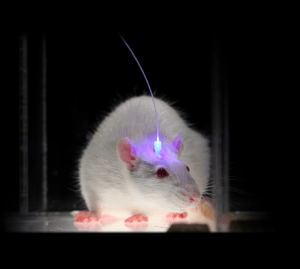
Optogenetics is a method of controlling living cells using light and genetic engineering. Each neuron (brain cell) has its own genetic code, allowing it to synthesise proteins. Scientists can add a new gene to this genetic code, thereby creating an additional blueprint for protein synthesis. This allows the cell to synthesize opsins: proteins that respond to light. A couple of recent studies have used optogenetics to target specific neurons in the amygdala, a region of the brain that regulates emotions, to enhance or erase fear-based memories.
In one of the aforementioned studies, rats were conditioned to fear high-pitched noises. Then, a new gene was implanted that coded for opsins. As a result, when the rats were exposed to a low-frequency light, they experienced no fear during exposure to the high-pitched sound. This suggests the memories of the conditioned fear were erased, based on the placement of the new gene. This is a step above current techniques for memory erasure, which include exposure therapy, which involves un-conditioning the conditioned fear. With current techniques, most times the fear will resurface later, whereas with optogenetics the fear has not been seen to surface again.
In a similar study, scientists monitored and altered levels of acetylcholine in mice brains. They found that high levels of acetylcholine enhanced memories, leading to the memories lasting up to twice as long, while acetylcholine deprivation led to the absence of memory. Similar to the study using optogenetics, the area in the brain that the acetylcholine was administered affects which memories are erased. This could potentially help patients suffering from PTSD (post traumatic stress disorder), as if the memory can be erased, the fear and anxiety surrounding the memory will also disappear.
An additional study found that an essential component of memory erasure was the removal of calcium-permeable receptors (AMPARs). AMPARS are found at excitatory synapses, or gaps between two neurons, which is a gap that is more likely to transmit a signal. These receptors aid in the quick transmission of a signal. If the AMPARs are removed, the signal transmission is consequently slow and the memory may not be formed or recalled.
These advancements in optogenetics could potentially aid the processing of legal cases that rely on eyewitness testimony. Christine Blasey Ford, a professor at Palo Alto University, accused Supreme Court nominee Brett Kavanaugh of sexual assault. When asked how sure she was during her testimony to the Senate Judiciary Committee, she said, “the same way that I’m sure I’m talking to you right now, just basic memory functions, and also just the level of norepinephrine and epinephrine in the brain. The neurotransmitter encodes memories into the hippocampus, and so the trauma-related experience then is locked there.”
Despite her statement being correct, there were many details in her allegation that she could not remember. These details could have helped investigators to more solidly confirm or deny her allegation, which could have even changed the trial outcome. Applying what has been discovered about the effects of high levels of acetylcholine in the brain, in the future similar situations, memories could potentially be enhanced to recall such important details. However, there is still a way to go. Most of these experiments have been tested on rats, which brains are significantly less complex than humans. Because of this complexity, it may be especially difficult to target a specific area in the brain where the memory is located.
Although there are still many advancements to be made before these methods can be transferred onto human patients, there is potential for the future of both science, and the court system.

